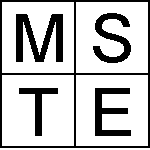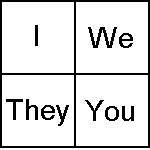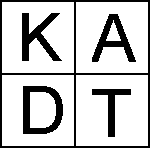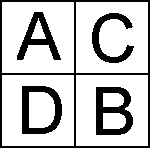A Conceptual Tour of
Mental Relativity
by Melanie
Anne Phillips
Before we begin an exploration of the details of
the Mental Relativity model, it will help to have an overview of where we are going. By
examining the promise of the model, it will make the value of a tedious journey into the
theory behind the model more apparent.
To begin with, there are striking similarities
between Mental Relativity and the structure of DNA. But, whereas DNA is represented as a
double helix, Mental Relativity is represented as a quadruple helix.
The first two helices are structural in nature, and
by themselves appear, when modeled, almost identical to a "ball and stick" model
of DNA. The second two helices, however, are dynamic in nature, and exist only
conceptually as a description of how the sequence of bases in the structural double helix
is determined.
We are not unaware of the potential application of
the Mental Relativity theory to such areas as genetics, but our purpose here is to explain
a model of the mind.
One might ask why a model of the mind should bear
any resemblance to a model of DNA at all. From a Mental Relativity standpoint, the answer
is that these patterns do not exist independently of our perception of them. In fact, the
reason we see a spiral in a galaxy, a hair pattern, or a DNA molecule is that the observer
is always projected onto the observation. The data are what they are. The pattern is a
perceptive ordering of the data.
One might expect that with a quadruple helix there
would be eight bases instead of four. In actuality, there are sixteen bases. This is
because the number of base building-blocks required to generate all of the permutations of
the relationships both within and among the helices is the square of the
number of helices.
Each set of four bases is a separate family called
a Quad, with one Quad pertaining to the outward-looking view, one to the
inward-looking view, one to a structural view and one to a dynamic view. These four views:
outward, inward, structural, and dynamic, are the four most elemental relationships
between self and that which is not self. They the basis of all interactions and
alterations between observer and observation.
The four inward-looking bases of the model are
Knowledge (K), Thought (T), Ability (A), and Desire (D).
The four outward-looking bases are Mass (M), Energy
(E), Space (S), and Time (Ti).
The four structural bases are Universe (U), Mind
(Mi), Physics (Ph) and Psychology (Ps).
The four dynamic bases are I (I), You (Y), We (W)
and They (Th).
It is the interactions among these sixteen bases
that determines the exact "genetic sequence" of experiences of any given
self-aware entity along its path of existence stretching between non-existence that was
and non-existence to come.
When we bring all four Quads of bases together, one
visual representation of the resultant pattern is the quadruple helix already mentioned.
Although this is an elegant model, it is also difficult to work with. A more practical
representation which is more accessible for purposes of analysis and construction is
represented below:

Here, the horizontal axis of the matrix represents
the impact of the bases KTAD - the inward-looking view. The vertical axis of the matrix
represents the impact of the bases MEST - the outward-looking view. The semantic terms at
the top of the model, which are within the matrix represent the influence of the
bases UMPhPs and determine the structural palette of experiences available to
self-awareness. The final Quad of the four bases (IYWTh) are applied to the model
conceptually and determine the dynamic forces which act upon the model to determine the
sequence of experiences actually perceived.
If you click on the image above, you can navigate
through the model from the top to the bottom. You will note that the original semantic
representations of Universe, Mind, Physics, and Psychology are continually subdivided into
progressively more detailed Quads. Each semantic term in the matrix represents a unique
mix of influences from the three Quads of bases physically represented in the model.
The reason only three of the four Quads of bases
are physically present in the model is that only three have an objective aspect with which
to tie them together. MEST is an objective look at objectivity. KTAD is an objective look
at subjectivity. UMPhPs is a subjective look at objectivity. IYWTh is a subjective look at
subjectivity, and therefore has no touch point in which it might be attached to an
objective model. If we were to take the opposite approach and create a subjective model,
it would be three fourths conceptual, making it much less useful as an analytic and
predictive tool.
In a sense, this visualization of the four Quads of
bases resembles something of a cross between a three dimensional Periodic Table of Mental
Elements and a Rubik's Cube. In practice, it used essentially as both.
The semantic terms order experiences spatially by
families, not unlike the Periodic Table of Elements in chemistry. But, rather than
representing such things as Nobel Gasses, Rare Earths and so on, the principal families in
the Mental Relativity model are Classes, Types, Variations, and Elements.
Each of these families is represented as one of the four vertical planar levels in
the model, with Classes at the top and Elements at the bottom.
We can see that the original four Classes fall into
sixteen Types which generate sixty-four Variations based on two hundred fifty six
Elements. Each semantic term attached to the model describes the blended influence of the
three Quads on that particular position in the model and also serves as the family name
for the Quad which falls directly beneath it.
For example, in the second level from the top in
the Physics Class we find the semantic Type name, "Understanding". This is
descriptive of the meaning of the particular conjunction of the influences of all three
Quads of bases at that point, but also serves as a family name for the four Variations
beneath it: "Instinct", "Conditioning", "Senses", and
"Interpretation".
The fractal nature of the model is quite apparent
by noting that the internal relationships among the items in any Quad interrelate in much
the same way as the items in any other Quad. For example, internal relationships in the
Instinct, Conditioning, Senses, Interpretation Quad bears a striking similarity to the
internal relationships among the items "State of Being", "Sense of
Self", "Situation" and "Circumstances" in the Quad of Variations
under the "Conceptualizing" Type in the Psychology Class.
An examination of the model will show that the
State of Being Quad is in the same relative position in the Psychology Class as the
Instinct Quad is in the Physics Class. Because meaning in the model is based on position,
the more similar the position, the more similar the feel of both the terms themselves and
the relationships in their respective Quads.
This is hardly surprising, since Knowledge is not
unlike Mass or Universe, Thought has a kinship with Energy, and Mind, Ability has
connections to Space and Physics, and Desire touches on issues of Time, and Psychology.
Putting all four Quads together, the concept of
relationship based on position becomes clear:




All the items in the upper left seem more singular
or definitive. The items in the lower right seem to be those which most directly impact
the item in the upper left. The items in the upper right seem like they require some sort
of comparison. The items in the lower left seem more all pervasive. Of course, these are
just broad generalizations, but the fractal nature of the model based on position can be
clearly seen. In fact, even the four Quads of bases share the same kind of relationships
as items in a larger Quad.
An important note is the relationship that
"I" is in the same position as "Knowledge". This is because the
semantic terms we have chosen for the model are influenced by the choice of selecting an
"objective" model in the first place, rather than the subjective one. As a
result, a consistent bias is built into the matrix itself favoring objectivism, which
ultimately requires that self be defined based on one's Knowledge.
It should be kept in mind that there are other
possible models which represent other biases as well. This particular bias was chosen
because it best reflects the inherent biases of Western society, which is the atmosphere
in which the model was created, and therefore the most plentiful variety of semantic
terms. We are, in a sense, limited by our own language. It is impossible to complete any
model that is free of bias since we, the observer, always have a point of view. But, it is
our hope that theorists in other cultures will take it upon themselves to translate the
semantic terms into their own language so that the validity of the relationships is
maintained while merely the point of view is altered.
Another point we might note in the four Quads
represented above is that the diagonally related items share a special bond. The
bonded pairs in each group of four have a similar flavor from group to group. Mass and
Energy seem to operate in a more physical sense, while Space and Time seem more like
appraisals. Similarly, Knowledge and Thought appear the cornerstones of reason, whereas
Ability and Desire strike us being more judgmental. Universe and Mind are states of
things, Physics and Psychology describe processes. I and You are singular, We and They are
plural.
At an observational level, the diagonal bonding is
the most obvious pair relationship, again due to the objective bias of the model. But once
we delve into the realm of the applied Dynamics which rearrange the model like a Rubik's
Cube, other bonded pair relationships become apparent. The nature of these other pairs
(such as horizontal or vertical bonds) each has different properties which are displayed
in varying degrees of strength.
Dynamically, the I, You, We, They Quad is applied
to the physical representation of the model. This is accomplished in a practical sense by
assigning each of these four points of view to one of the Classes. When this is done, each
Class and all the Types, Variations, and Elements beneath it become the Domain of
the point of view associated with it.
For example, Universe might be the "You"
Domain or the "We" Domain. Clearly, based on the four Quads of bases represented
above, Universe should always associate with "I", not "You" or
"We". That is why dynamics are created. The choice of where to associate the
points of view determines the in which ways our point of view warps our perspective of
objective reality, or in other words, how each observer uniquely alters an observation.
When each of the four points of view have been
associated with each of the four Classes, we get a sense of the nature of a mental
entity's bias. In a sense, this is not unlike getting a sense of a DNA strand as belonging
to a plant or an animal.
The next degree of refinement comes when we choose
the focus of attention for each point of view in each of the vertical levels in the model.
For example, if Mind is selected as the You Domain (meaning that in this sequence it is
someone else's mind that is the focus of attention) then what Type or aspect of that other
person's mind are we most concerned with: Memory, Conscious, Subconscious, or
Preconscious? Once we make our selection, we have further refined the association of that
point of view with the objective model.
It should be noted that although each Class must
receive a point of view, the choice as to which POV goes to which Class is completely
arbitrary. By arbitrary we do not mean that it has no impact, but rather that any
combination will create a viable sequence. But, just as with DNA, every allowable sequence
creates a different end product.
To complete our association of points of view to
Classes, we determine on which Variation in each class the point of view focuses, and
finally the elemental issue that is the root or anchor point for each point of view in
each Class.
Having arrived a complete association of all four
points of view to all four Classes, the dynamic instructions have been completely encoded
into the model. What remains is to let them act upon it and put things into motion.
To illustrate the manner in which motion occurs,
let us take a generic Quad labeled ABCD:

This Quad represents any family of Elements in the
bottom level of the model. To see how dynamics operate on the Quad, let us imagine a
mental irritation. This might be something in one's environment that is detrimental or
desired but absent or an internal quality that is present and not wanted or wanted and not
present.
If the irritation persists, it reaches a point
where a charge of energy is built up on that point, for the human mind which is
based on neurons that charge does not respond until it experiences a great enough single
impact (spatial summation) or an impact of sufficient duration (temporal summation).
Once that flash point is reached, a neuron will
fire. Having fired, its action potential is reduced, and it cannot fire again until
a certain period of time transpires. This is due to its exhaustion of the needed
biochemical components which were depleted during the firing process.
In our generic Quad, suppose mental item
"D" becomes irritated through spatial or temporal summation to the point that it
"fires". In that event, the Quad will (in a sense) spin about the AB axis so
that D and C exchange places. This effectively moves the irritated "D" out of
the way, and scabs it over with "C".
If no further irritation continues, D will
eventually rebuild its exhausted potential and the Quad will return to its initial
position. Psychologically, this is akin to a concept called extinction. But, if the
irritation remains and brings item C to the point of response before D is ready to resume
its original position, then the Quad finds itself in something of a dilemma. It can
neither flip C and D, nor can it wait any longer.
In this case, a more drastic response is necessary.
The "mechanism" of the mind moves up one level to the Variations. Here it will
flip an entire Variation with its diagonal pair, and drag the Elements below it along for
the ride. In this manner, a larger shift in perspective overcomes a greater intensity of
mental irritation.
Once again, if the irritation diminishes or stops,
all affected Quads will unwind in time. If the irritation continues, the mind bumps up to
the Type level and performs the same procedure. If the Type level is irritated, the Class
above that Type will flip with another Class. But at this point, something different has
happened. Universe will have swapped places with Mind or Physics with Psychology.
Effectively an irritation which objectively resides as an external consideration is now
perceived by the mind as an internal problem or an issue which is "really"
internal is now seen to come from the outside environment (or someone else!). This process
is known in psychology as projection.
Once the mind has gone through four processes of
dynamically shifting perspective, it has exhausted a whole Quad of mental defense
mechanisms and bumps itself up to the next family of dynamics. When this happens, the
previous Quad of responses is no longer available, effectively locking their impact in
place so that (in regard to the specific irritation) the projection between internal and
external will not unwind on its own. In fact, it takes a complimentary irritation
beginning at the Class level and working its way down to bring thing back into alignment.
So, from an originally neutral or balanced state,
self-awareness now has a built in bias (or sensitivity) that is reflective of past
experience, rather than immediate stimulation. It is this mechanism that allows us to
anticipate, and is the source of both our motivation and our blind spots.
By itself, a single winding up of the model is
linear in nature. In contrast, the mind is much more non-linear in its function. The model
reflects this as well, as there will, in fact, be two Classes that "wind up" in
response to any given irritation. The two Classes will be a bonded pair so that, for
example, an irritation may be perceived as between Mind (what we want) and Universe
(what we have), in conversational terms. Similarly, the irritation might be perceived
between Universe (the way things are) and Physics (the way things are going).
The deepest resolution of a problem that the mind
can simultaneously appreciate is that it might be between two Classes as opposed to
residing solely in one. This is because (as documented in other articles) in any given
Quad, the mind must blend two of the items in order to compare the other two against each
other. In brief, the reasons for this are due to the order in which the mind moves from
one perspective to the next so that any given perspective ultimately gets a second
"viewing" at a later time, allowing for a sense what has changed. Since the mind
cannot be everywhere at once, we find that at some moments we are thinking about our
feelings and at other moments thinking about a logistic issue.
The manner in which we mentally shift around a Quad
determines that one pair in a Quad will get a "double exposure" while the other
pair will only have each item visited once. As a result, the mind approximates a sense of
change in the items seen only once, but playing one against the other as if they were two
viewings of the same item. This synthesizes the parallax of a true double reading,
providing an extra edge of probable accuracy, but at the expense of blending two concepts
into one.
As an example, when we separately consider or
interact Knowledge and Thought in our minds, we blend Desire and Ability into
Desirability, which effectively means that we cannot engage in a logical analysis without
to some degree being affected by our emotional state.
This contention leads to a whole new line of
inquiry which is covered in other articles regarding Mental Relativity. For now, we have
completed the purpose of this article, which was to provide a conceptual overview of the
structure and dynamics of the Mental Relativity model of the mind, and to hint at its
basis in established views of neurology and psychology.
In a sense, Mental Relativity stands between
neurology and psychology to show how they affect and reflect each other.
